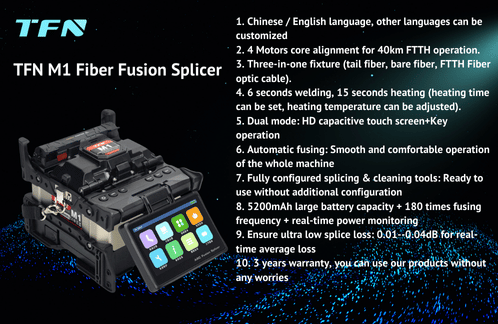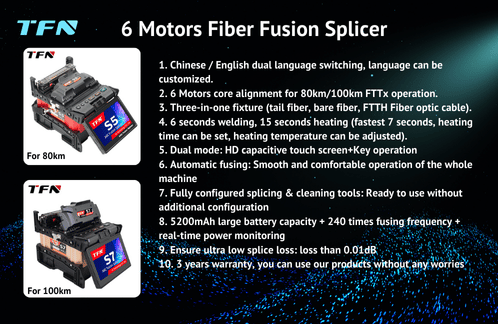Differences between ribbon fiber fusion splicers and ordinary fiber fusion splicers
As important equipment in the field of optical communications, fiber fusion splicers are widely used in the construction and maintenance of optical cables and production testing of optical fiber devices. Among them, ribbon fiber fusion splicers and ordinary fiber fusion splicers are two common fiber fusion splicing equipment, and there are significant differences in function, application and operation. This article will discuss the differences between the two in detail from the aspects of fusion quality, fusion speed, applicable fiber types, and ease of operation.
1. Welding quality
The ribbon fiber fusion splicer has significant advantages in terms of welding quality. The equipment uses advanced welding technology to ensure the high consistency of the diameter and geometry of the welding joint area through accurate temperature control, axial stretching, eccentricity and pressure control. This high-precision control makes the quality of the fiber joints welded by the ribbon fiber fusion splicer more stable and reliable, reducing the occurrence of problems such as breakage and expansion. In contrast, ordinary fiber fusion splicers are difficult to achieve the level of ribbon fiber fusion splicers in terms of welding accuracy. The quality of the fiber joints after welding may be affected by many factors, and it is difficult to ensure long-term stability.
2. Welding speed
In terms of welding speed, ordinary fiber fusion splicers usually have faster welding speeds. Because the ribbon fiber fusion splicer uses more complex welding technology and precise control mechanisms, its welding process takes a relatively long time to complete. Ordinary fiber fusion splicers are relatively simple and can quickly complete the welding process, improving work efficiency. However, this also requires a trade-off, because the increase in speed may sacrifice welding quality to a certain extent.
3. Applicable fiber types
The ribbon fiber fusion splicer is mainly suitable for the fusion splicing of ribbon fibers. Ribbon fiber is a flat fiber composed of multiple optical fibers. Its overall splicing requires that multiple core optical fibers be spliced at the same time and heat-shrink protected at the same time, which has the characteristics of fast and convenient splicing. Ordinary fiber fusion splicers are not only suitable for ribbon fibers, but also can be used to splice other types of optical fibers such as single-core optical fibers. Therefore, when choosing a fusion splicer, users need to choose the appropriate equipment according to the specific application scenario and fiber type.
4. Ease of operation
The operation of the ribbon fiber fusion splicer is relatively complicated, and the operator needs to have certain professional knowledge and skills. Since its fusion process involves multiple precision control steps, the operator needs to be extra careful when operating. In contrast, the operation of ordinary fiber fusion splicers is relatively simple and easy to use. However, with the continuous development of technology, some ribbon fiber fusion splicers have added humanized designs, making their operation more convenient and lowering the operating threshold.
5. Actual application scenarios
Ribbon fiber fusion splicers are mainly used in the construction and maintenance of optical cables in optical communications, especially in situations where multi-core optical fiber splicing needs to be completed quickly and effectively. For example, in the fields of telecommunications operators, engineering companies, and scientific research institutes, ribbon fiber fusion splicers play an important role. Ordinary optical fiber fusion splicers are widely used in the construction and maintenance of various optical fiber communication networks, including the splicing and testing of single-core optical fibers.
In summary, there are significant differences between ribbon fiber fusion splicers and ordinary optical fiber fusion splicers in terms of splicing quality, splicing speed, applicable optical fiber types, and ease of operation. When choosing, users need to comprehensively consider various factors based on their actual needs and application scenarios to choose a splicer model that suits them.


If you are interested in TFN fiber splicing machine, please contact TFN sales team:
Email: info@tfngj.com
WhatsApp: +86-18765219251
Facebook: https://www.facebook.com/tfnfate/
